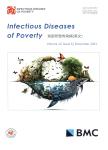Evaluating active leprosy case identifcation methods in six districts of Nepal
作者机构:Epidemiology and Disease Control Division Department of Health Services Ministry of Health and Population Kathmandu Nepal Epidemiology and Disease Control Division-Malaria Program Management Unit- SCI-GF Kathmandu Nepal Leprosy Control & Disability Management Section EPidemiology and Disease Control Division DoHS Kathmandu Nepal Lalgadh Leprosy Hospital & Service Center Nepal Leprosy Trust Lalgadh Nepal Molecular Epidemiology and Public Health Laboratory Infectious Disease Research Centre Hopkirk Research Institute Massey University Palmerston North New Zealand Center for Health and Disease Studies-Nepal Kathmandu Nepal DEJIMA Infectious Disease Research Alliance Nagasaki University Nagasaki Japan
出 版 物:《Infectious Diseases of Poverty》 (贫困所致传染病(英文))
年 卷 期:2023年第12卷第6期
页 面:105-106页
核心收录:
学科分类:1002[医学-临床医学] 100206[医学-皮肤病与性病学] 10[医学]
基 金:EDCD World Health Organization, WHO Ministry of Health and Population, MoHP Royal Society Te Apārangi, (MAU1701) Massey University
主 题:Leprosy Early case detection Community-based epidemiology Hidden case New case detection rate Attack rate Cost per case identifed Nepal
摘 要:Background Nepal has achieved and sustained the elimination of leprosy as a public health problem since 2009,but 17 districts and 3 provinces with 41%(10,907,128)of Nepal’s population have yet to eliminate the *** cases and grade-2 disabilities(G2D)indicate recent transmission and late diagnosis,respectively,which necessitate active and early case *** operational research was performed to identify approaches best suited for early case detection,determine community-based leprosy epidemiology,and identify hidden leprosy cases early and respond with prompt *** Active case detection was undertaken in two Nepali provinces with the greatest burden of leprosy,Madhesh Province(40%national cases)and Lumbini Province(18%)and at-risk prison populations in Madhesh,Lumbini and Bagmati *** detection was performed by(1)house-to-house visits among vulnerable populations(n=26,469);(2)contact examination and tracing(n=7608);in Madhesh and Lumbini Provinces and,(3)screening prison populations(n=4428)in Madhesh,Lumbini and Bagmati Provinces of *** case direct medical and nonmedical costs for each approach were *** New case detection rates were highest for contact tracing(250),followed by house-to-house visits(102)and prison screening(45)per 100,000 population ***,the cost per case identifed was cheapest for house-to-house visits[Nepalese rupee(NPR)76,500/case],followed by contact tracing(NPR 90,286/case)and prison screening(NPR 298,300/case).House-to-house and contact tracing case paucibacillary/multibacillary(PB:MB)ratios were 59:41 and 68:32;female/male ratios 63:37 and 57:43;pediatric cases 11%in both approaches;and grade-2 disabilities(G2D)11%and 5%,*** leprosy was not signifcantly diferent among household and neighbor contacts[odds ratios(OR)=1.4,95%confdence interval(CI):0.24-5.85]and for contacts of MB versus PB cases(OR=0.7,95%CI 0.26-2.0).Attack rates were not signifcantly d



